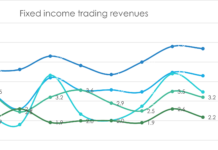Trade bodies have set their stalls against the introduction of planned capital rules in the US, which would create additional costs for banks seeking to trade in leveraged products.
The International Swaps and Derivatives Association (ISDA) submitted a response with the Securities Industry and Financial Markets Association (SIFMA) on the US Basel III ‘endgame’ notice of proposed rulemaking (NPR), warning that the resulting increases in capital for bank trading activities do not reflect underlying risks and could impact the liquidity and vibrancy of US capital markets, increasing costs and reducing choice for US businesses.
“Based on an industry quantitative impact study (QIS) with input from eight US global systemically important banks (G-SIBs), the introduction of the Fundamental Review of the Trading Book (FRTB) and the revised credit valuation adjustment (CVA) framework would result in a 129% increase in market risk and CVA risk-weighted assets (RWAs) under the new expanded risk-based approach (ERBA) versus the current US standardized approach,” said the organisations in a joint statement.
The Futures Industry Association (FIA) has likewise said it strongly opposes provisions of the two separate proposed rules put as these would dramatically increase capital requirements for derivatives clearing services that banks offer to their clients.
“Looking at just the six largest US banks that offer clearing, FIA estimates that these provisions would increase their capital requirements for client clearing by more than 80%. If enacted as proposed, these rules would make it far more expensive for banks to provide their clients with clearing services for futures, options, and over-the-counter (OTC) derivatives,” it wrote. “In turn, this could impair access to these instruments by a wide range of companies that use derivatives to hedge their risks or manage their investments.”
The FIA says that it is troubled by the absence of any apparent cost-benefit analysis that considers these important negative impacts of the proposals on end users and on systemic stability and has also urged the US bank regulators to fully consider and analyse these impacts before finalising rules.

“In the wake of the 2008 financial crisis, regulators recognised the need to move more of the derivatives markets into central clearing,” said Walt Lukken, CEO of FIA. “They understood that central clearing is one of the most effective ways to make the financial system more stable and resilient when markets are in turmoil. That makes it all the more surprising that US bank regulators are ignoring one of the most important lessons of the financial crisis. Policymakers should not disincentivise the very activity that makes the marketplace safer, reduces systemic risk, and protects taxpayers.The proposals being considered will drive up the cost of client clearing for end-users that rely on these products to manage risk. FIA calls on US bank regulators to carefully consider the impact these proposals will have on the cleared derivatives markets and the farmers, energy companies and pension funds that rely upon them to manage volatility.”
The ISDA/SIFMA response proposes a number of calibration changes to make the rules more ‘appropriate and risk sensitive’ which would also avoid ‘adverse consequences’ to US capital markets according to the association.
• A comprehensive evaluation of how the proposal would interact with other prudential requirements, particularly the stress testing framework and the G-SIB surcharge (and related calibration), is needed.
• The proposal would have a negative effect on the liquidity and vibrancy of capital markets. In response, US agencies should make certain critical revisions detailed in the letter to improve the recognition of diversification when calculating market risk RWAs under the ERBA to reflect actual risk exposure and effective risk management practices.
• The proposal would increase capital requirements for markets where that outcome would not be aligned with underlying risks. The agencies should mitigate adverse effects by making key changes set out in the letter for market risk and CVA RWAs under the proposal.
• The proposal would adversely affect derivatives end users, including commercial end users, corporate and banking organizations, resulting in negative effects on investors. To avoid these significant impacts to derivative end users, as well as knock-on consequences to consumers, the agencies should enhance the risk sensitivity of the capital framework in the proposal.
• Aspects of the proposal would result in excessive volatility or material increases in capital in a manner that is not aligned with the risks and would disincentivise banking organizations from adopting the FRTB internal models approach. In response, US agencies should make key revisions to the proposal’s market risk framework, as detailed in the letter.
If material changes to the calibration cannot be achieved without further consultation, a re-proposal of the rules may be necessary, ISDA says. To ensure banking organizations have sufficient time to implement the requirements, the response recommends the rules should become effective no earlier than 18 months from the publication of the final rule.
ISDA and SIFMA also submitted a response to a separate consultation by the US Federal Reserve on proposed changes to the G-SIB surcharge.
That response raises concerns that the revised G-SIB surcharge would lead to inappropriately high capital requirements for banks offering client clearing services, potentially discouraging them from participating in this business and contravening a long-standing policy objective to promote central clearing.
Specifically, the response argues that client derivatives transactions cleared under the agency model should not be included in the complexity and interconnectedness categories of the G-SIB surcharge calculation. Failure to make this change would raise capital requirements across six G-SIBs that contributed to a QIS by US$5.2 billion.
The response also recommends that the standardised approach for counterparty credit risk alpha factor should not be included in the interconnectedness indicator calculations, cross-jurisdictional activity indicators should not include derivatives exposures and that, at a minimum, derivatives exposures should be net of cash and non-cash collateral in the cross
©Markets Media Europe 2023
©Markets Media Europe 2025













